|
|
|
Sort Order |
|
|
|
Items / Page
|
|
|
|
|
|
|
| Srl | Item |
| 1 |
ID:
182761
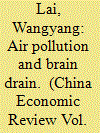

|
|
|
|
|
| Summary/Abstract |
This paper provides one of the few evidence about migration responses among talents to air pollution. Specifically, we investigate the impact of PM2.5 concentration on job location decisions of Chinese college graduates at the beginning of their professional careers. The results indicate that a 10-unit increase in PM2.5 concentration raises college graduates' probability to leave their current city by 10% point. We also find larger impacts on graduates from elite colleges and less polluted hometowns. Our empirical results are consistent with a simple model in which the location choice of college graduates depends on their wage payment and air pollution. Our findings supplement existent literature in documenting important ways in which air pollution may associate with the loss of highly-educated talents.
|
|
|
|
|
|
|
|
|
|
|
|
|
|
|
|
| 2 |
ID:
182769
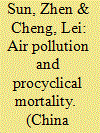

|
|
|
|
|
| Summary/Abstract |
There is growing evidence that in developed countries, mortality rises (falls) in economic booms (busts). However, little is known about the cyclical pattern of mortality in developing countries. Using China's city-year data, we find that the total mortality in China also exhibits procyclical fluctuations. In exploring the mechanisms, we find that air pollution is one of the reasons for procyclical fluctuations in total mortality. Specifically, economic booms lead to severe air pollution, worsening human health and thus increasing death rates. Moreover, we find that changes in lifestyles may not be an important reason for procyclical mortality in China.
|
|
|
|
|
|
|
|
|
|
|
|
|
|
|
|
| 3 |
ID:
182760
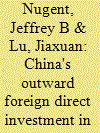

|
|
|
|
|
| Summary/Abstract |
Because of the potentially large and important effects of the extremely ambitious Belt and Road Initiative (BRI) launched by China in late 2013, considerable attention has been given to the motives for, and repercussions of, the BRI-driven infrastructural projects. Yet, the non-infrastructural outward foreign direct investment (FDI) from China to BRI countries, which varies quite substantially across different sectors and different countries, has not yet received much attention. In contrast to some recent studies showing that the massive initiative has increased China's total FDI outflows to fellow BRI countries, in this paper, based on our sector-level difference-in-differences models, we find that effect to be statistically insignificant. Yet, at the same time, we provide empirical evidence on the sectoral pattern of China's outward FDI before and after 2014 indicating that China's FDI outflows to BRI countries have significantly increased in sectors characterized by overcapacity and contributing to pollution in China, thereby demonstrating that China's BRI-driven outward FDI has been very selective in terms of sectors. We confirm these findings with a variety of robustness checks and show that it is BRI countries with relatively low institutional quality that have been more likely to receive these types of FDI from China. We thus speculate that Chinese firms have been motivated to place FDI investments in BRI countries for the sake of alleviating China's own overcapacity and pollution problems. Our findings lead us to suggest that, although these sectoral patterns are consistent with the different stages of economic development in which China and its fellow BRI-identified countries find themselves, Chinese investors and host country governments should be more concerned with the potential for unwanted side-effects of the FDI investments so that the mutually beneficial effects of the BRI can be sustained into the indefinite future among all countries involved.
|
|
|
|
|
|
|
|
|
|
|
|
|
|
|
|
| 4 |
ID:
182775
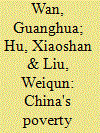

|
|
|
|
|
| Summary/Abstract |
Miracle reductions in absolute poverty led China to announce, in late 2019, the strategic change from targeting absolute poverty to targeting relative poverty. After highlighting China's success in the fight against absolute poverty, this paper attempts to assess the roles of growth and income inequality in affecting both absolute and relative poverty rates. Poverty decomposition and panel-VAR modelling results show that growth played an overwhelming role in achieving the miracle of poverty reduction but relative poverty has been consistently rising. And growth, contrary to the case of absolute poverty, actually has contributed to the rising trend of relative poverty. Conversely, income inequality has played a small role in aggravating absolute poverty but a moderate role in raising relative poverty. Therefore, it seems appropriate for China to continue targeting absolute poverty with a higher poverty line. In the case that China insists on shifting the poverty alleviation strategy, market-led growth can no longer be relied on to reduce relative poverty. Instead, government-led pro-poor policies must be instituted by providing employment, education, training and other opportunities to the disadvantaged groups, in addition to the usual social assistance.
|
|
|
|
|
|
|
|
|
|
|
|
|
|
|
|
| 5 |
ID:
182770
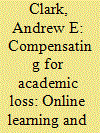

|
|
|
|
|
| Summary/Abstract |
The COVID-19 pandemic has led to widespread school shutdowns, with many continuing distance education via online-learning platforms. We here estimate the causal effects of online education on student exam performance using administrative data from Chinese Middle Schools. Taking a difference-in-differences approach, we find that receiving online education during the COVID-19 lockdown improved student academic results by 0.22 of a standard deviation, relative to pupils without learning support from their school. Not all online education was equal: students who were given recorded online lessons from external higher-quality teachers had higher exam scores than those whose lessons were recorded by teachers from their own school. The educational benefits of distance learning were the same for rural and urban students, but the exam performance of students who used a computer for online education was better than those who used a smartphone. Last, while everyone except the very-best students performed better with online learning, it was low achievers who benefited from teacher quality.
|
|
|
|
|
|
|
|
|
|
|
|
|
|
|
|
| 6 |
ID:
182767
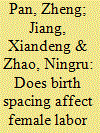

|
|
|
|
|
| Summary/Abstract |
This paper investigates the impact of birth spacing on female labor market participation in urban China. Employing household panel surveys between 1989 and 2011 and exploiting variations in time intervals between the first and second child, we find that spacing births at longer intervals significantly increases female labor market participation. The effects of birth spacing are robust to various examinations that consider nonlinear specifications, selection on observed and unobserved variables, and the plausibly exogenous instrument. The heterogeneous analysis suggests that the effects of birth spacing are more pronounced in women with a daughter as the first birth, women with late first birth, and less-educated women. We examine potential mechanisms and document that women with longer birth intervals are likely to invest more in continuing education and have better health status.
|
|
|
|
|
|
|
|
|
|
|
|
|
|
|
|
| 7 |
ID:
182768
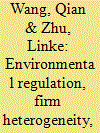

|
|
|
|
|
| Summary/Abstract |
We describe a model with firm heterogeneity and endogenous pollution abatement to show how emission intensity and exit/entry selections vary across firms. Using Chinese firm-level emission and production data, we find evidence that low productivity firms have higher emission intensity. The emission intensity of firms with productivity below 10 percentile is 5.26 times larger than firms with productivity above 90 percentile. Combining the Annual Survey of Chinese Industrial Enterprises (CIE) data, and applying a triple-difference research design, we find that firms with high emission intensity or low productivity have a higher probability of exit when exposed to strict environmental policy. We also find the exit of unproductive firms contributes to aggregate productivity and strict environmental policy can help to reduce misallocation.
|
|
|
|
|
|
|
|
|
|
|
|
|
|
|
|
| 8 |
ID:
182758
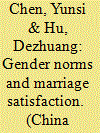

|
|
|
|
|
| Summary/Abstract |
This paper examines the association between the traditional gender division norm — “men are breadwinners, and women are homemakers” — and the marriage satisfaction of each gender using Chinese couple-level data. The results reveal that married couples tend to be less satisfied with their marriage if the wife earns more than the husband. Moreover, it seems that the drop in the husband's marriage satisfaction matters more for the drop in the couple's overall marriage satisfaction. By exploring the difference between husbands and wives in their attitudes in terms of economic contribution and housework contribution, we confirm that husbands may have a specific self-image regarding the traditional gender division norm, and can also respond to the wives' gender role preference.
|
|
|
|
|
|
|
|
|
|
|
|
|
|
|
|
| 9 |
ID:
182762


|
|
|
|
|
| Summary/Abstract |
This paper investigates the impact of social trust on a firm's adjustment speed toward an optimal capital structure. Leveraging the availability of generalized trust and personalized trust metrics in China, we find that, as expected, when a firm is located in a high social trust region (with either generalized or personalized trust), it adjusts more quickly toward its target capital structure. Moreover, we document that the impact of generalized trust (personalized trust) on the adjustment speed is magnified if the firm already had stringent financial constraints (less-severe agency problems) but it is not related to the severity of a firm's agency problems (financial constraints). Additional analysis suggests that the impact of social trust on capital structure dynamics is primarily through debt rather than equity. Furthermore, we find that when a firm is located in a weak formal institutional environment, the impact of generalized trust on the adjustment speed strengthens, suggesting that formal institutions and generalized trust are partial substitutes. Interestingly, the substitution effect of formal institutions and personalized trust is weak. Hence, the impact of generalized trust and personalized trust on capital structure adjustment share some similarities but differ in other respects.
|
|
|
|
|
|
|
|
|
|
|
|
|
|
|
|
| 10 |
ID:
182773


|
|
|
|
|
| Summary/Abstract |
In Chinese cities, migrants with rural hukou, compared to residents with local urban hukou, face more uncertainty, have limited access to mortgage finance, and are less eligible for low-cost housing. A simple model demonstrates that for these reasons, rural-to-urban migrants are less likely to own housing units in cities and as a result accumulate less wealth. Our empirical analysis examines a nationally representative household survey from 2013 and uses mother's hukou status as an instrumental variable. We find that household heads with rural hukou are about 20 percentage points less likely to own housing units in cities than comparable household heads with local urban hukou. Consequently, the average household head with a rural hukou owns 315 thousand yuan less housing wealth and 226 thousand yuan less total wealth than comparable household heads with local urban hukou. The average household head with a rural hukou has 288 thousand yuan less in housing capital gains than comparable household heads with local urban hukou. Moreover, we find that these differences are much larger in the first- and second-tier cities, cities with more stringent hukou regulations, and among younger cohorts.
|
|
|
|
|
|
|
|
|
|
|
|
|
|
|
|
| 11 |
ID:
182764


|
|
|
|
|
| Summary/Abstract |
We construct a pseudo panel sample from the China General Social Survey to study the inequality of opportunity in China. The pseudo panel enables us to control for cohort-specific heterogeneities when estimating the Mincer equation, and the results show that individual circumstances play a prominent role in determining income advantage. Counterfactual analysis further reveals the importance of cohort-level circumstances: individual circumstances account for less than 10% of the observed income inequality, whereas equalizing both the individual circumstances and the cohort fixed effects reduces income inequality by 30%. Among the individual circumstances we examine, gender and paternal characteristics contribute more to income inequality than does hukou of birth. Subsample analysis shows that China's western provinces exhibit the highest inequality of opportunity and that the inequality of opportunity among younger cohorts is smaller than that among older cohorts.
|
|
|
|
|
|
|
|
|
|
|
|
|
|
|
|
| 12 |
ID:
182771


|
|
|
|
|
| Summary/Abstract |
Whereas numerous studies have evaluated the effects of public research and development (R&D) support programs and R&D tax incentives on private R&D, little is known about local governments' fiscal incentives for R&D. In this study, we build a conceptual framework to clarify the critical role of local land supply in relation to fiscal expenditure on R&D. We treat the establishment of China's nine Land Supervision Bureaus in 2006 as a quasi-natural experiment, and run a difference-in-differences regression to identify causality. The results show that local governments allocate more fiscal expenditure to R&D in response to land-use supervision, which monitors illegal land granting behaviors, and this effect is stronger in cities where leaders have higher political career incentives and cities with greater fiscal decentralization. Moreover, we find that land-use supervision increases the probability and scale of firms' access to government subsidies for R&D; thus, enhancing regional innovation capacity. Our findings document that China's land resource is a curse for its innovation-driven growth as it impedes local governments' fiscal incentives for R&D.
|
|
|
|
|
|
|
|
|
|
|
|
|
|
|
|
| 13 |
ID:
182759
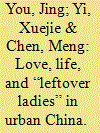

|
|
|
|
|
| Summary/Abstract |
The population in urban China has shown rising age at first marriage and declining marriage rates, especially among college educated professional women who are in their late 20s or their 30s. We investigate the determinants of marriage formation for urban women aged 27 or above who tend to be termed “leftover ladies”. We estimate a recursive mixed-equation model to describe correlated profiles of career, education and marriage. Conventional social norms on gender, especially patriarchy, still prevail. Factors that are not favorable for a conventionally wifely role reduce women's likelihood of marriage. In particular, we reveal a “marital college-discount” of college education. It reduces the probability of marriage by 2.88%–3.6% and a postgraduate degree further oppresses it by 8.4%–10.4%. Favorable characteristics such as facial attractiveness only raises the likelihood of marriage formation for non-college educated women, while pushing up non-marriage probabilities for women with at least college degrees.
|
|
|
|
|
|
|
|
|
|
|
|
|
|
|
|
| 14 |
ID:
182763
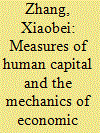

|
|
|
|
|
| Summary/Abstract |
We examine the mechanism by which human capital affects economic growth and convergence, using provincial level panel data from China. We specify alternative measures of human capital and apply them to an enhanced growth model, which we estimate parametrically, nonparametrically, and with a threshold model. Our results show that economic convergence is pronouncedly conditional on human capital across all measures. The positive “benefit of being backward” due to lower initial income is almost trumped by the negative impact of low levels of human capital in the poorest areas.
|
|
|
|
|
|
|
|
|
|
|
|
|
|
|
|
| 15 |
ID:
182774


|
|
|
|
|
| Summary/Abstract |
To see whether the population aging in China will significantly affect the gap of Urban Employees' Basic Medical Insurance (UE-BMI) in China, we first project the gap of UE-BMI's pooling account in the next fifty years. Then, we build an 80-genaration overlapping generation (OLG) model by modeling the UE-BMI at both aggregated and individual levels. The baseline model is calibrated and solved to be consistent with our projection, where UE-BMI's gap will bring visible pressure on China's fiscal budget in the next decades. In our policy experiments, our simulation under different fertility scenarios reveals that increasing fertility cannot effectively reduce the gap of the UE-BMI. Meanwhile, a low fertility in the future will induce a permanent welfare loss of households. Increasing the employer contribution rate or canceling the personal accounts of the UE-BMI could relieve the gap issue. However, the existence of crowding-out effects may potentially prevent the government from applying these reforms.
|
|
|
|
|
|
|
|
|
|
|
|
|
|
|
|
| 16 |
ID:
182766
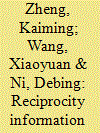

|
|
|
|
|
| Summary/Abstract |
This paper considers a modified principal-agent environment, where principals can use personalized offers based on agents' reciprocity-related information. With such information, principals can either impose stronger financial incentives or try to “trigger” agents' positive reciprocity by offering a higher fixed rate. Theory suggests that principals who believe in agents' reciprocity would personalize offers so that reciprocal agents increase their effort beyond the self-regarding benchmark. Using a lab experiment, we test the behavior of principals and agents. Our experimental market witnesses significant wage personalization when reciprocity information is available. However, agents' effort levels and principals' payoffs are lower under wage personalization, compared with the sessions where principals cannot personalize offers. Our structural analysis shows that, under wage personalization, agents expect higher fixed wages and reciprocate higher wages less. Information about agents' individual reciprocity is more correlated with the expected wages, rather than the strength of reciprocity toward higher or lower wages. Principals grant higher fixed wages to workers with lower wage expectations, but because principals cannot personalize offers effectively according to the strength of reciprocity, the performance of wage personalization is limited.
|
|
|
|
|
|
|
|
|
|
|
|
|
|
|
|
| 17 |
ID:
182772


|
|
|
|
|
| Summary/Abstract |
This paper estimates the effect of the “selective two-child” policy (The “selective two-child” policy allowed couples to have two children if one member of the couple was an only child (1-OC family)). on the resource allocation between generations amongst urban households in China by referring to the nationally representative China Household Finance Survey (CHFS). The results of propensity score matching (PSM) and difference-in-difference (DID) show that the total and per capita expenditures on children education are reduced significantly after the implementation of the “selective two-child” policy, testifying to the quantity-quality trade-off of children in Chinese families. Nevertheless, the financial support for the elderly not living in the household does not decrease, suggesting no intergenerational competition. Furthermore, the total and per capita expenditures for the qualified families decreased significantly, which indicates that the loosening of fertility policy may lead to new-oriented and unintended precautionary saving motives.
|
|
|
|
|
|
|
|
|
|
|
|
|
|
|
|
| 18 |
ID:
182765


|
|
|
|
|
| Summary/Abstract |
In 2009, China launched a nationwide reform to overhaul its enormous healthcare system. Subsequently, government spending on healthcare increased significantly. Simultaneously, public hospitals experienced rapid expansion. This study empirically examines whether supply-induced demand existed for public hospitals during the expansion process, based on hospital longitudinal data from 2007 to 2016, which is matched with individual patient data. We found that medical expenditure increased rapidly, while the quality of medical services did not change significantly during the hospital expansion. In addition, due to the price regulation of medical services, public hospitals mainly passed on the costs of expansion by inducing hospitalization and diagnostic over-testing. Furthermore, supply-induced demand was more obvious in diseases for which doctors had more asymmetric information. Based on the evidence provided in this study, the expansion of public hospitals has resulted in a waste of healthcare resources and a rise in the healthcare burden on patients. This has certain implications for further deepening the reform of public hospitals.
|
|
|
|
|
|
|
|
|
|
|
|
|
|
|
|
|
|
|
|
|